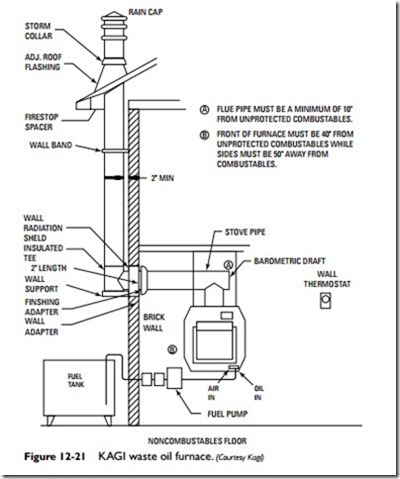Air Conditioning
A furnace used in conjunction with a cooling unit should be installed in parallel or on the upstream side of the evaporator coil to avoid condensation on the heating element. In a parallel installation, dampers or comparable means should be provided to prevent chilled air from entering the furnace.
Duct sizing should include an allowance for air conditioning, even though it may not be initially installed with the furnace. Air conditioning involves a greater volume of air than heating.
All ductwork located in unconditioned areas (attics, crawl spaces, and so on) downstream from the furnace should be insulated to prevent unwanted heat gain.
Starting the Burner
The procedure for starting an oil burner may be summarized as follows:
1. Open all warm-air registers.
2. Check to be sure all return air grilles are unobstructed.
3. Open the valve on the oil supply line.
4. Reset the burner primary relay.
5. Set the thermostat above the room temperature.
6. Turn on the electric supply to the unit by setting the main electrical switch to the on position.
7. Change the room thermostat setting to the desired temperature.
The oil burner should start after the electric power has been switched on (Step 6). There is no pilot to light as is the case with gas-fired appliances. The spark for ignition is provided automatically on demand from the room thermostat. Allow the burner to operate at least 10 minutes before making any final adjustments. Whenever possible, use instruments to adjust the flame.
Oil Furnace Spillage
In oil-fired furnaces, the inefficient incomplete combustion of the oil will cause sulfur dioxide (SO2) gas to spill from the furnace. Spillage commonly occurs during the few seconds during the initial
startup of a conventional oil furnace, which is not a problem, but it can occur more often, and well beyond the initial startup period, in a poorly maintained furnace. Sulfur dioxide gas in large quantities can be harmful to the lungs. It has a strong, unpleasant odor. The problem can be eliminated by:
1. Fitting a delayed-action solenoid valve to the gas burner (see Delayed-Action Solenoid Valve in this chapter) to increase the efficiency of the combustion process.
2. Install a well-balanced barometric damper in the flue pipe.
3. Seal all flue pipe joints against leaks.
